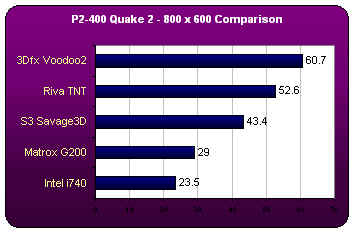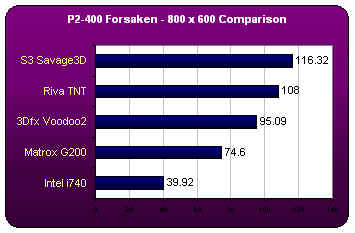July '98 Graphics Accelerator Comparison
by Anand Lal Shimpi on July 20, 1998 5:34 PM EST- Posted in
- GPUs
Intel Pentium II 400 on an ABIT BX6 Motherboard (Intel SE440BX was used for the Savage3D tests)
64MB PC100 SDRAM
Western Digital 5.1GB Ultra ATA Hard Drive
AOpen 32X IDE CD-ROM Drive
Windows 98 with all of the latest patches/drivers installed
The Super7 Tests were not conducted as not all boards were compatible with Super7 chipsets during the time of testing. More tests on the Super7 platform will be conducted in the future once all current issues have been resolved.
The benchmark suite consisted of the following full version game titles
Forsaken - Running the Nuke Demo
Turok Dinosaur Hunter run with the '-benchmark' option
Quake 2 v3.14 using Demo1.dm2 and Brett "3 Fingers" Jacobs Crusher.dm2 demo
Ziff Davis' Winbench 98 was used to test 2D performance at 1024 x 768 x 16-bit color.
VSYNC was disabled during AnandTech's tests (VSYNC is the synchronization of all buffer swaps to the refresh rate of your monitor, theoretically limiting the attainable frame rate by the refresh rate your monitor is set at. Disabling it will improve performance but may degrade visual quality by introducing "tearing")
Ziff Davis Winbench 98 - 2D Performance |
||
| - | Business | High End |
| - | Windows 98 - P2 400 | Windows 98 - P2 400 |
| G460 i740 8MB | 206 | 274 |
| Matrox G200 8MB | 207 | 269 |
| Riva TNT 16MB | 216 | 263 |
| Savage3D 8MB | 190 | 269 |
The Riva TNT comes out on top by a small margin under Business 2D Performance leaving the Savage3D at the bottom of the list, when the scene switches into High End Application Performance (2D) the i740 takes the lead over the Matrox G200 and the Savage3D, leaving the Riva TNT at the bottom of the pile this time. For best overall 2D performance, the Matrox G200 allows for a 24-bit color depth to be selected with a performance approximately 10 - 15% greater than the competition at 16-bit color depths. For 2D acceleration, the Matrox G200 comes out on top.
Pentium II Test System - Quake 2 - Open GL Performance |
||
Pentium II 400 |
Timedemo - 640 x 480 | |
| - | demo1.dm2 | crusher.dm2 |
| G460 i740 8MB | 37.4 | 28.5 |
| Matrox G200 8MB* | 41.3 | 28.3 |
| Riva TNT 16MB | 57.0 | --- |
| Savage3D 8MB | 60.6 | Failed |
| - | Timedemo - 800 x 600 | |
| - | demo1.dm2 | crusher.dm2 |
| G460 i740 8MB | 23.5 | 20.9 |
| Matrox G200 8MB* | 29.0 | 23.3 |
| Riva TNT 16MB | 52.6 | --- |
| Savage3D 8MB | 43.4 | Failed |
| - | Timedemo - 1024 x 768 | |
| - | demo1.dm2 | crusher.dm2 |
| G460 i740 8MB | 13.8 | 12.6 |
| Matrox G200 8MB* | 18.1 | 15.8 |
| Riva TNT 16MB | 34.9 | --- |
| Savage3D 8MB | Failed | Failed |
* The Matrox G200 was using a
Direct3D Wrapper for the Quake 2 tests, performance should improve once a Full OpenGL ICD
is released
Note: The crusher.dm2 benchmark was not available at the time of the Riva TNT benchmarking

For Quake 2, it seems like the Riva TNT is the best performer out of the bunch however it is closely followed by the S3 Savage3D in terms of performance. Once the TNT reaches its full performance potential expect the gap between the Savage3D and the TNT to somewhat reflect the price difference between the two chipsets, also you can expect the Matrox G200 to begin to give the Savage3D a bit of a threat from the lower end once the Full OpenGL ICD is released. As for the i740, all that can be said is, nice try.
Pentium II Test System - Forsaken - Direct3D Performance |
|
Pentium II 400 |
Frame Rate - 800 x 600 |
| - | Nuke Demo |
| G460 i740 8MB | 39.92 |
| Matrox G200 8MB* | 74.6 |
| Riva TNT 16MB | 108.03 |
| Savage3D 8MB | 116.32 |
| - | Frame Rate - 1024 x 768 |
| Nuke Demo | |
| G460 i740 8MB | 26.3 |
| Matrox G200 8MB* | 46.37 |
| Riva TNT 16MB | 63.84 |
| Savage3D 8MB | Failed |
The kings of Direct3D go at it as the Savage3D manages to edge out the Riva TNT in performance under Forsaken. While the Matrox G200 still remains competitive, for the money, the Savage3D offers much more value from a performance perspective. Now, for the true test, let's see how well these cards stack up to a Voodoo2











0 Comments
View All Comments